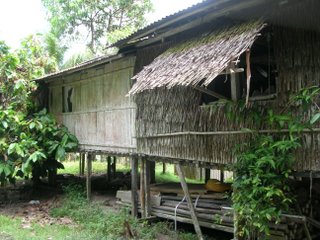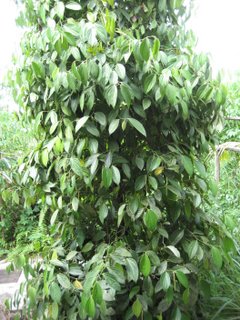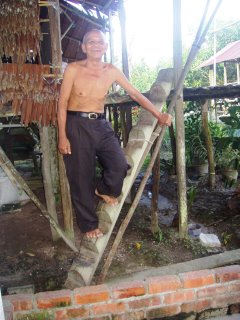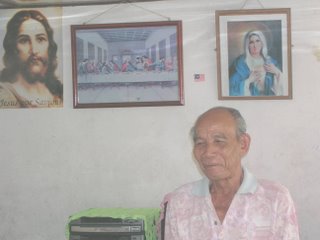Gawai in a Bidayuh Village


Travel stories often start with such personal anecdotes. Bruce Chatwin starts In Patagonia with a story about a piece of prehistoric hide. Eric Hansen, who wrote Stranger In the Forest about his travels across Borneo, tells about stalking his mother's tea party with a bamboo spear. It might be a literary convention but it seems to me a means by which we seek to make sense of our lives. There might be other reasons why I am in Sarawak, but then again there might not.
I have arrived back for the second year to teach for three months in the MPH program at the University of Malaysia in Sarawak or UNIMAS as it is called. It is the start of the new university year. Last year's students are finishing off their exams. I teach epidemiology and management. Luckily it being my second year I have most of my sessions already made up into powerpoint presentations.

Shortly after I arrived in early June, the annual celebration of Gawai was held. Gawai means harvest so it's similar to Thanksgiving, especially for the Iban and Bidayuh groups which constitute the majority. We were invited by a Bidayuh friend, Rose, to visit her village. We were feted to speads of exotic sweets, sticky, coconut rice steamed in long stems of bamboo, and many special delicacies all laid out on rattan mats in her father’s home, her younger sister’s home and several of her cousins’ homes. While we were in each home, large family groups would arrive to visit and eat. Everyone was glad to see Rose who is pursuing her Phd. in Kuala Lumpur and was home for the holidays. We could hardly move through the tightly packed Bidayuh villages, they were so congested with cars coming and going. The visiting that takes place reminds me of the Open Houses of Christmas Eve when I was a kid. Wonderful eating, great parties and much socializing.

We lamented with Rose's Dad, the loss of his Padi (rice) house, mostly because it had a beautiful Bidayuh log staircase cut from a single log. Luckily I had taken a picture last year which I was able to share with them. In one of her cousin's home there was a stack of pepper bags from their own trees stored in the corner. The parents both hold jobs and do their farming in the evening when they get home. Pepper is one of the cash crops of Sarawak.

We lamented with Rose's Dad, the loss of his Padi (rice) house, mostly because it had a beautiful Bidayuh log staircase cut from a single log. Luckily I had taken a picture last year which I was able to share with them. In one of her cousin's home there was a stack of pepper bags from their own trees stored in the corner. The parents both hold jobs and do their farming in the evening when they get home. Pepper is one of the cash crops of Sarawak.
Many Bidayuh have plots of land around or beside their house. A few Bidayuh still live in long houses but most now live in separated houses in villages. Unlike the Malay in the rest of Malaysia, the Bidayuh are mainly Christian. Many, like Rose's family, are very devout. The Bidayuh are one of the ethnic groups that were called Land Dayaks and were favoured by the Rajahs. Most of them speak English and /or Malay partly because the numerous dialects make communication between the various subgroups difficult.
After a hectic day of feasting we staggered home full of good will and even better food. Sticky rice is the real treat and Rose's sisters had prepared a number of bamboo tubes of coconut flavoured sticky rice for us to take home.

Then the next day we drove to the white beach in Santubong, the only beach worth the name near Kuching according to the Lonely Planet. Being Gawai, it was crowded and overbooked so we completed a 250 km. drive to find an excellent seafood restaurant on the Sarawak River closer to home.

My Burmese friend Aye has collected more Bidayuh baskets since my last visit. Baskets in Sarawak are so exquisite it is hard not to collect. I'll add some pictures of Bidayuh baskets, a pepper tree, food laid out on rattan mats, log staircase and padi house.
Labels: Sarawak


3 Comments:
Breeze--welcome to the blogosphere! I am so pleased to find your blog--it is lovely! And great photos, too. Please, give us more. I have tried to find your location, but Google Earth will only get me to Borneo; it doesn't know Sarawak. Where on the island is that? And who are the White Rajahs of your first book? And why did Rose's dad lose his padi house--fire? flood? Enquiring minds want to know! If you are ON the equator, is there any summer or winter, or is it just hot-hot-hot all the time? So different from sub-Arctic Alaska that it is hard to imagine.
Keep up the good work, I'll check in regularly!
Thanks for the welcoming comments, khaty and tundra PA More on White Rajas and geography to come.
Great article, I'm a Bidayuh too. There are lots you need to explore about the Bidayuh community.
Post a Comment
<< Home